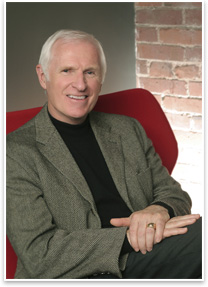
| Jim
Jonassen, FAIA
Education: BArch from the University of Washington; master of science in architecture from Columbia University. Hobbies: Downhill skier, bad golfer, sailor, voracious reader. Last book read: I just finished three books. Awakening Hippocrates: A Primer on Health, Poverty, and Global Service, by Edward O’Neil Jr, which looks at the relationship between global poverty and health; The End of Poverty: Economic Possibilities for Our Time, by Jeffrey Sachs, which analyzes and lays out what it takes to solve and end poverty, much like Ed Mazria lays out the challenge for reducing greenhouse gas emissions; and Confessions of an Economic Hit Man, by John Perkins, who describes how wealthy corporations exploit developing nations. Perhaps my favorite is Team of Rivals, by Doris Kearns Goodwin, which describes how Abraham Lincoln assembled a team with totally diverse skills and motivations to achieve great results. It is a lesson for us all in collaboration, timing, and teamwork. First job: I joined NBBJ right out of Columbia. Major professional influence: One would be one of the founding architects of NBBJ, Perry Johansen. Another is a client I had a lifetime relationship with, the late Allan Lobb [executive director of the Swedish Medical Center in Seattle]. He was a true Renaissance man. I’m also at a stage of my career now where I am rediscovering some important things, including the work of Nobel Prize winner Albert Schweitzer, who was a hero of my generation and a germane person today in the moral imperative that directed his medical pursuits and his work as a theologian and writer. He had a reverence for life that is a terrific guidepost today. Major career accomplishment: There are two or three things I would like to highlight. One, I was lucky enough to be in this firm early enough to reshape, reenergize, and fine-tune the design practice and build a highly respected health-care practice. I was also able to help build a local and regional firm into an international practice that has become one of the five largest internationally, at least in terms of volume. And I’m also proud to be an agent for change in the firm, and of the many hats I’ve worn at NBBJ—with the first as CEO of Western operations, then as managing partner for the entire firm, then sharing the role as it—was subdivided with other partners. Now I’m the managing partner in charge of delivery. Definition for “agent for change”: That means looking continually at what is next and thinking about the ways that we can transform ourselves to take advantage of changes in the marketplace and culture. It also involves finding the next great minds in architecture and bringing them to our firm to support this culture. Next for architecture practice: An example of that type of profound change is the move toward integrated delivery. It is an incredible cultural shift that demands that we as architects learn to collaborate in the design process with builders and clients in a way we have not done previously. We are enabled by building information modeling, or BIM, to address many inefficiencies and evils of practice. Integrated delivery is a new way to develop projects that can help eliminate waste in the industry by 30 percent. Even if we can achieve only half of that, we can help the fight against world poverty and redirect resources to developing the infrastructure we need to move toward cleaner energy sources and a more sustainable environment. All these opportunities are interwoven. Integrated practice definition: It means that architects have a say—all the way through completion—at the table of ultimate decision making. It also means that the risks and the rewards are shared among the owner, architect, and builder. The collaborative team approach takes a lot of adversarial risk out of project disputes, and it is a lesson for us all in collaborative work. Our economic success is tied together. Next practice evolution: Another imperative is that of the threat to life on our planet, which has a lot to do with energy use. We have a social responsibility to look at all aspects of energy and fossil fuel use. Architects must be leaders, and we must find the public and political will to make that happen. We have to get public awareness well beyond where it is now. This is a public issue that is impossible to ignore. Practice tip for colleagues: We must look at what we have in front of us as a practice culture and assess the way we integrate with fabricators, owners, and enlightened clients to develop an integrated process in which we are all tied together by a single agreement. I’m optimistic that through an integrated mode of delivery we can achieve these goals and use it as a way to meet the 2010 and 2030 challenges for fossil fuel reduction. |
||
Copyright 2006 The American Institute of Architects. All rights reserved. Home Page |
||
news headlines
practice
business
design
Visit NBBJ online.

